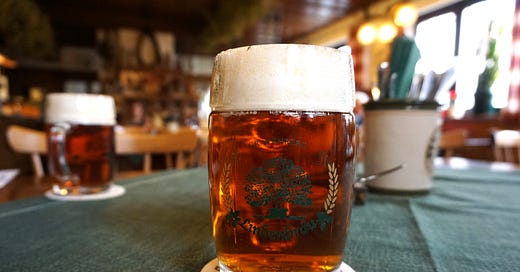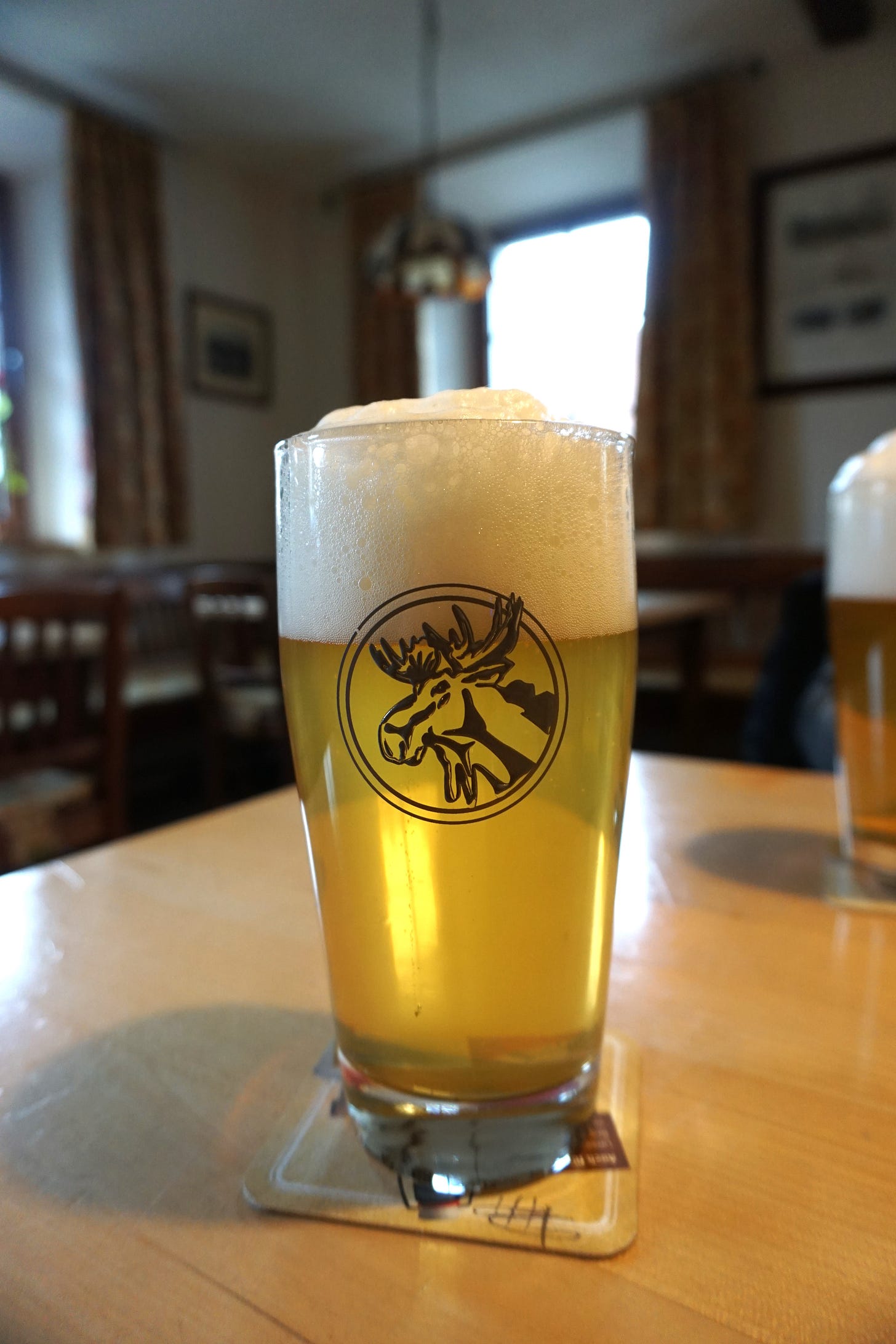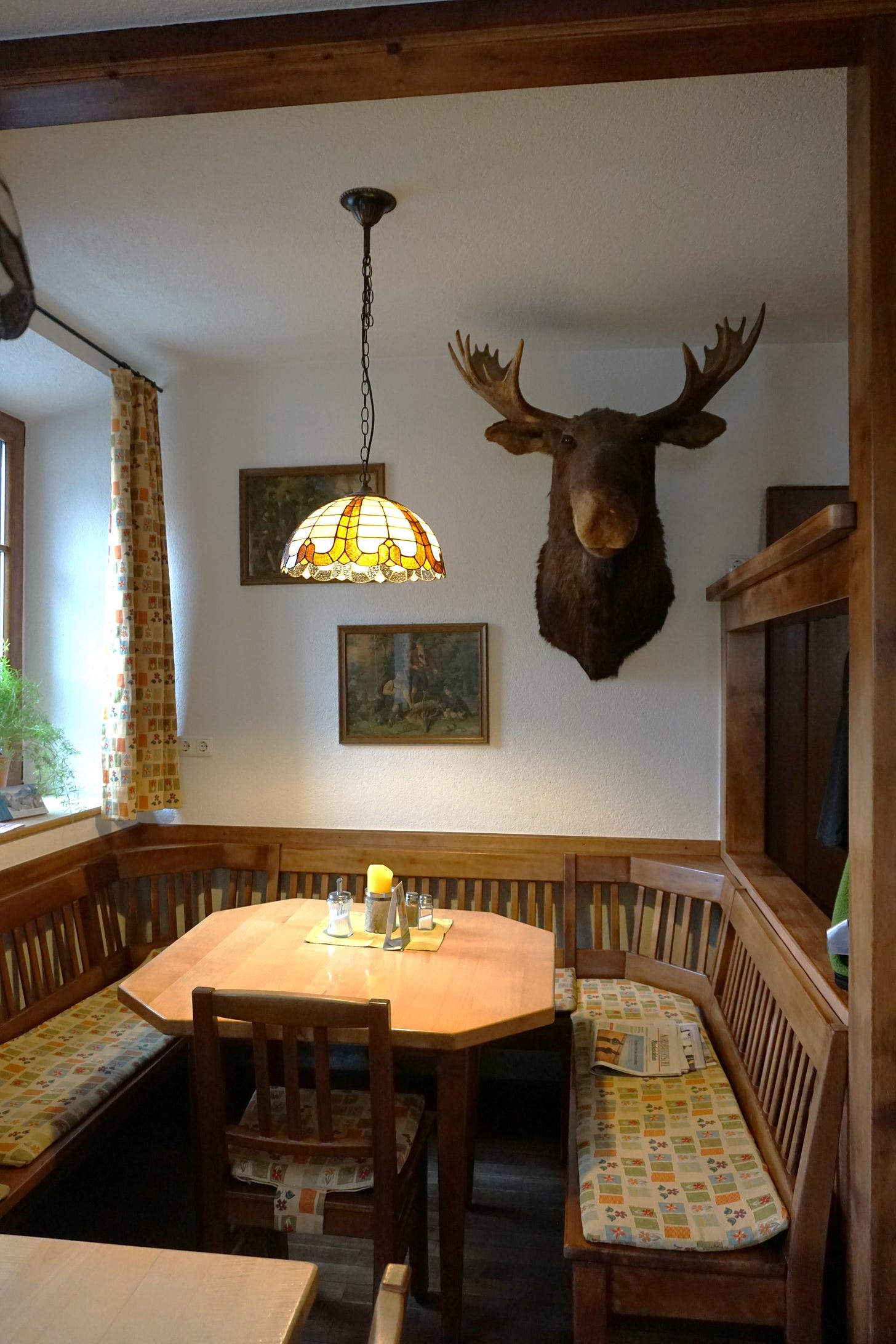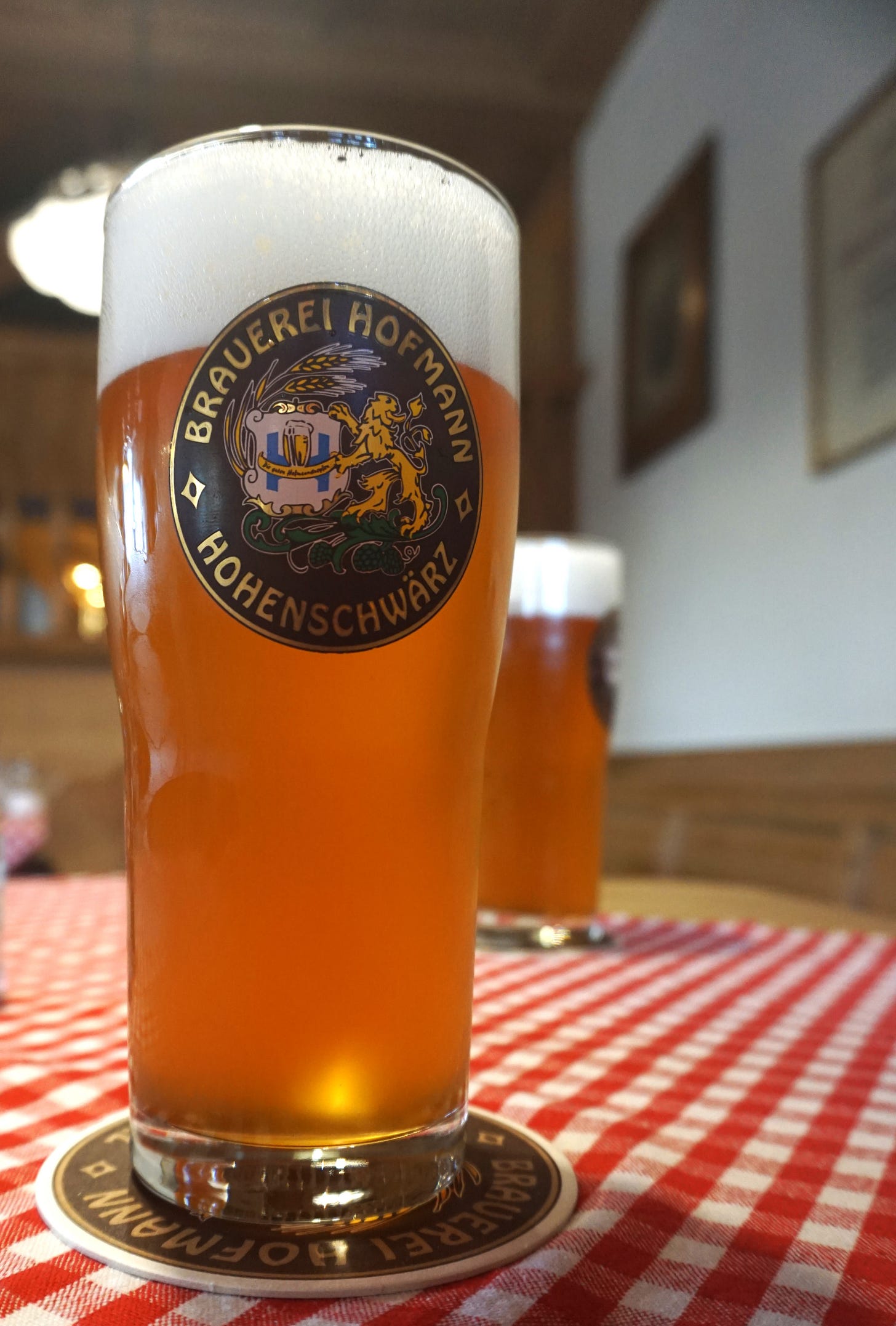The best beer experience of my life?
Recalling the time I hiked Germany's Fünf-Seidla-Steig, and all the great beers I had along the way.
It has been an unusual month, folks. Without divulging too much information, I’ll simply note that I got sick for the second time in four weeks—a total rarity for me. At the same time, I’ve felt myself falling behind on my work here. And by here, I mean on this newsletter. In the week or two ahead, I intend to recalibrate, pool ideas, and ensure I’m writing stories that add value to you the reader and to myself.
In the meantime, I’m going back into the vault to share one of my favorite beer experiences: the time I hiked the Fünf-Seidla-Steig in Germany.
Expect to read more stories from beyond Thailand in the months to come, too. After all, it’s a wide world, and I love to explore it through beer wherever I go.
Drinking beer in the morning, and I’m not even in college anymore.
I was raised to believe certain truths. For example, “civilized people do not drink before noon,” and “alcohol and exercise should never mix.”
In Germany, at the age of 33, I realized both were lies.
Early on a February morning a few years back, my wife and I entered Brauerei Elchbrau in Thuisbrunn and ordered a beer. It would be the first of five1 that day, and it would serve as the first official fuel stop for a 10-kilometer journey over hill and dale, deep into the heart of rural Franconia.
Which is to say: it was the first leg of the Fünf-Seidla-Steig.
One of Germany’s great beer hikes2, the Fünf-Seidla-Steig connects five small breweries around Gräfenberg, a region of woods and farmland in Franconia, north of Nuremberg, which very much reminded me of the American Midwest where I grew up. You can either perform a 19k loop or go point-to-point, as we did. Whichever method you choose, you must order a Seidla—the Franconian word for a half liter of beer—at five breweries along the way to complete it (and get the stamps to prove it).
The trail itself isn’t very old. It was founded in 2008 to bring tourism to an otherwise overlooked and under-visited area. From what the barman at Elchbrau explained, it has certainly done that in the past 15 years. “But you’re going to be the only ones on the trail today,” he told us with a laugh. “No one does this in winter.”
Breakfast beers: totally okay
Breakfast beers at Elchbrau.
A fun fact about Franconia: it’s home to more breweries per square kilometer than any other area in Europe, according to the local tourism board. When you consider Germany’s penchant for being outdoors, it’s only natural that it would be set up for self-guided beer crawls, or even bike rides from one town’s brewery to the next.
The idea was something of a novelty for me, but it also appealed to my sensibilities. Namely, a love for beer and physical movement. I was born for this, basically.
After catching the 8am bus from Nuremberg to Thuisbrunn, the earliest I’ve ever used public transport to go to a bar3, we arrived at Elchbrau shortly after it opened at 10am. We weren’t the first patrons.
In the corner of the room sat an elderly couple, both a half pint into their day. They were dressed in cable-knit sweaters and chatted with the man who ran the bar. In fact, they had to call him out of the kitchen to let him know that two other customers—i.e., us—had wandered in and needed service. I don’t often picture retirement, but when I do, I think of the couple in this rustic little tavern.
Elchbrau had four beers on tap: a dunkel, pilsner, weizen, and kellerbier. Not knowing which was the more appropriate choice for breakfast, I went with the kellerbier while my wife ordered the pilsner (above).
The namesake elk.
An unfiltered lager, the kellerbier hails from Franconia and is usually the popular choice at summer beer gardens.4 Elchbrau’s was refreshing, with a subtle citrus flavor and plenty of body.
Had it not been 2 degrees Celsius, I’d have loved to entrench myself in the beer garden to appreciate the kellerbier in its preferred setting. Instead, we sat inside under the frozen gaze of a taxidermized elk.
Landbiers and other such jargon
Very delicious beer, also enjoyed before lunch.
One beer down, we put our jackets on and hoofed it to stop two, Brauerei Hofmann Hohenschwärz.
The fun thing about a beer hike like the Fünf-Seidla-Steig is that, unless you have several pints at every stop, you tend to hike with a warm, fuzzy feeling that makes the time fly by. It took us about 40 minutes to reach Brauerei Hofmann, but it seemed to take no time at all.
This community brewhouse has plied its trade since 1897 and is still run by the same family that founded it. I realized quickly that it must be a treasured local institution, because it was absolutely packed at 11am, again with an older crowd who were putting in serious work on weizens and dunkels.
Unlike my fellow patrons, I went for the landbier.
What exactly is a landbier, you ask? Excellent question. The word translates to “country beer,” and it’s a catch-all in Franconia for any unfiltered, bottom-fermented house beer. In other words, it’s a local lager, and it’s one of Hofmann’s recommended beers, along with its dunkel and seasonal festbier.
Like essentially all breweries in the region, Hofmann uses local ingredients and traditional techniques to make its beers. It should go without saying that every beer I had over the course of the day was amazing. The credit for this excellence almost certainly goes to this zealotry for tradition and process—a belief that getting the little things right can take you further than simply making more products.
It was equally fascinating to see breweries making world-class beer in villages much smaller than my dinky hometown, a place with a sizable German heritage where until recently there were no breweries whatsoever. The lesson here is that you may never be able to revive traditions once they slip away.
Into the woods
Midwest America or Franconia? You tell me.
Following the signs, we got back on the trail for the lengthiest stretch of the hike. From Brauerei Hofmann, the Fünf-Seidla-Steig takes you through the woods for about four kilometers to Lindenbräu Gräfenberg. In the depths of winter, it isn’t the most scenic journey you’ll ever experience.
Patches of hard-packed snow and ice covered the trail like bald spots, periodically revealing dead leaves and roots. The trees were barren, and the forest was silent, as if totally devoid of life. Spring, when German hikers would begin to do the Fünf-Seidla-Steig on weekends, felt a long way off. And summer, when the trail stays busy every day of the week, was basically an abstract idea at this point.
There’s nevertheless something peaceful about having the woods to yourself, no matter the season. I tend to get so anxious about my work that I’ll compulsively check my email every 10 minutes. When you’re in the middle of nowhere, though, emails are the further thing from your mind.
An excellent vollbier.
After an hour off-road, we arrived at Lindenbräu. I opted for the vollbier here.
Another new one for me, the vollbier, or “full beer,” is an amber-colored ale with high original wort content (about 11-14 degrees Plato). The style itself was created for tax purposes—the vollbier was taxed less than a strong beer, but more than a light beer. That makes it, essentially, a normal-strength beer that usually clocks in at 5%.
Minutiae aside, Lindenbräu’s vollbier had a rich, malty backbone, citrus notes, and light carbonation. It also registered at a healthy 5.2%, right in the sweet spot if you’re knocking back several pints in one day and your next stop is just around the corner.
Why don’t all towns look like this?
Family-run Brauerei Friedmann was just a few blocks away, exactly where it has been since 1875. I ordered the landbier—along with Sigi’s lager, one of the signatures here—and a sausage platter. The beer was clean and the sausages satisfying. I’m not sure there’s much else to say other than it was the fuel I needed to complete the circuit.
The end of the tour
Miraculously, I managed to take a photo of my beer here—my *counts fingers* sixth or seventh.
I’m no stranger to feats of endurance—as I’ve alluded to twice now, I run a lot—but having five-plus pints5 over the course of a hike certainly puts your stamina to the test. But I found a second wind by the time we reached Klosterbrauerei Weißenohe.
The brewery is attached to a church that has served the town since the 11th century. The brewery itself is likely just as old as the church, although it isn’t the Benedictine monk-run operation it used to be. In the 19th century, Klosterbrauerei Weißenohe was privatized and sold to the family whose descendants still run it today.
The beer line-up boasted all the usual players for this part of the world: a helles lager, a dunkel, a marzen, and others, all made in the Franconian style and brewed with natural spring water. I opted for the Altfränkisch, an excellent amber-hued landbier with enough bitterness to balance the caramel notes.
I was surprised to find gasp craft beer here as well. The current generation in charge of the brewery had experimented with single-hopped pilsners and even a cannabis-infused ale. They weren’t exactly TIPAs, but they were easily the most radical departure from tradition I’d witnessed in Franconia to that point.
We left the brewery buzzing and got on the bus back to Nuremberg as the sun was setting.6 We were, as we had been warned, the only hikers on the trail that day, but I could see the excursion being very popular in the right season. It struck me as more than a Franconian oddity, but rather the quintessential German experience. In fact, I believe the bierwanderweg just might be the most civilized way to drink beer.
Officially. I may have had more.
Bierwanderweg, because of course Germans have a word for this.
I think…
A zwickelbier, for what it’s worth, is the younger, lighter, less hoppy version of a kellerbier.
Don’t judge.
Winter in Germany. This happened at like 3pm.












